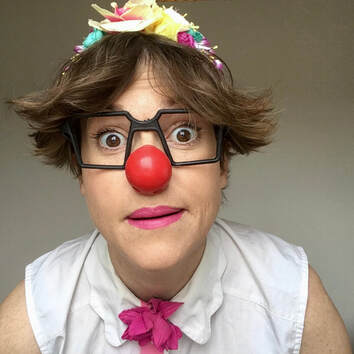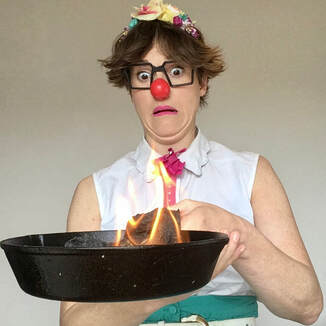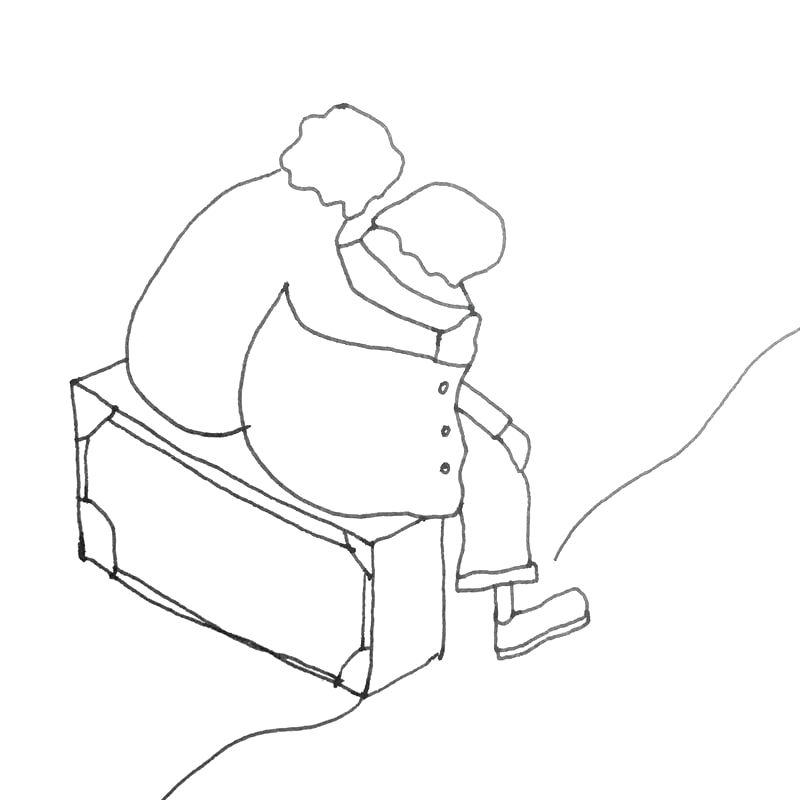|
This is a sketch - a kind of field guide to connection, inspired by a recent visit to a Carehome where I accompanied a mother living with dementia and her daughter on a journey to a new kind of conversation, with support from Rights Made Real and My Home Life.
Imagine a path that is paved as the person you love walks it. And imagine that you are walking alongside them. With each step, you walk, not towards a destination, but into each moment. The path is paved by the act of you being present in this moment, together. Each encounter is new, each path unique and full of possibility. Gently let go of the ‘how are yous’ of everyday meeting, for this is not an everyday meeting. Allow yourself, instead, a moment to notice what is beautiful, and to share it...’oh! My love! Look at your shining blue eyes!’ As you walk slowly along, you see signs - invitations - for you to follow, like symbols on a map. Perhaps a gesture, a word, a breath, a glint in the eye, a touch. You notice them all and choose to follow one. First, you observe, carefully, without judgement. Now you repeat, feeling it in your own mouth or body, discovering your own pleasure in it. Next, emboldened, you begin to build and gradually explore - curious for where this tributary will take you both. Through this exploration, your loved one knows that they have been seen, been heard. You confirm their place on this path, and that you are there, walking in-step. They sense that what they have said or done means something important to you, and is worth repeating. Hitting your stride now, you make an invitation of your own - exploration becomes exchange as the path clears and the horizon comes into view, the sun-kissed landscape rolling out before you. You lift your eyes together, at all the possibilities, full of ease, grace and wonder. You will see, of course, that not all invitations are possible for you to travel together. Some will be a dead end for you or for your loved one, some will feel disorientating or confusing, some will simply disappear as you move towards them. There will be times when you feel lost or stuck. When you can’t see any signposts at all, when the fog comes down and the compass is spinning. It’s natural now to feel the loss. The despair of what is no longer there. The vertigo and fear that comes with constant change. The desire to to make sense of the senseless. That’s okay. When that happens, pause on the path-side awhile, sit on your suitcase and breathe. the breath is your North Star. When you breathe together, you’ll never be truly lost.
1 Comment
Today I feel like I’ve been plugged back into the mainframe. I’m so full of energy; I spent the day coaching/clowning with a DanskehospitalKlovne duo near Copenhagen and wanted to share this beautiful moment:
It’s the end of the shift and we are laughing as we bubble back down the corridor, enjoying the afterglow of the day, heads already drinking a coffee in the staff room. There are two residents on the corner, maybe in their 80s, frail. One sitting, one standing in front of him. Not speaking or looking at each other. Sort of hovering in one another’s orbit. As we pass, one says something like ‘can you play that thing?’ to Zippo, gesturing to his guitar. Zippo stops and begins to play. By now, I’m on the threshold of the staff room door but when I hear the music, I’m drawn back like elastic. I stand beside standing man and we are already feeling the groove, knees bouncing, hands dancing. Opposite, sitting man looks up and his eyes shine. I begin to play the trombone in the air. He nods and picks up his air trumpet. Now I am on the mic with the tall man, scatting, chhh chh chhaah chhhh chh chhhah dippiddy dappidy...When I look back, the sitting man is now on the clarinet. I give the saxophone a go. He laughs and the lights go down and we are in a smokey jazz bar, playing our usual slot. We are in synch, in flow, light as a feather, eyes bright. The cool cat crowd hang on our every note. They are in the palm of our hand. Sitting mans eyes flick to my skirt and back again. I look down...my petticoat is showing. Mortified, I quickly hide it and look back at him for reassurance. He laughs heartily and nods as if to say ‘it’s okay, kid, you got away with it’ and we play on until the small hours... It’s good to get the band back together. As part of the HCIM International meeting, I was asked to be on a panel about leadership, there to represent the 'next generation of Artistic Directors' that are taking over from our Founder/Ceo's. By the time of the conference (it was delayed by 1 year) I had handed in my resignation, I wanted to be honest about my experience on the panel and somehow only Dr Maybee knew how. People have been a little taken aback by my use of the word failure when talking about this. But I'm comfortable with the word...you don't do clown training without becoming comfortable with it. Failure is central to our work...and while of course it is a vulnerable place to be, it is inevitable & natural and a source of great learning and power. In refusing to feel shame, I hope that I can provoke a wider conversation and learning about how we structure our organisations and how we empower one another to thrive - just as we empower the people we visit as Therapeutic Clowns. So here it is, Dr Maybee's Recipe for Failure.  Ingredients: 1 x beloved organisation transitioning from Founder/CEO/AD in the midst of financial difficulty with no strategy. 1 x Skilled therapeutic clown with no interest in business and a lot of passion for delivering best practice. 1 x Board in transition whose longest standing member has been in role for 2 years.  Method: Set the timer for 4 years.  Step 1: Gather your equipment:
Overhaul training, communication & costumes with the artistic team. See a sustained and bubbling improvement in morale and the quality of delivery. Check-in regularly, stir occasionally and continue for approx 18 months. I knew that I needed this in order to stay grounded and connected to myself and the work, and found it so challenging to ask for it, even though the CEO at the time was very supportive. It’s hard enough to know what your needs are and express them. It’s even harder to insist on them when it seems other things are more important to your colleagues or the organisation.  Step 2: When the CEO leaves suddenly, pour over anxiety and marinade for 2 months. Add an Interim CEO who is deeply sceptical about therapeutic clowning and keen to make his CEO mark. Turn up the heat, go to the board and get him removed. Vigorously mix your courage and leadership skills and suggest to the Board that the AD and CEO should occupy the same shelf to address future power imbalances. Simmer gently when the Chair says no. I had this sense that 'this isn’t my world'. Everyone else knows better/is more confident/understands more/is more experienced, so I didn’t voice my misgivings at first. I didn't feel I had the personal or positional power to express my concern. Of course, this is my 'stuff', but it also comes from the Patriarchal structures and systems that surround us, that have surrounded me since early childhood, that show leadership as a white middle aged man in a suit. The organisation relied on good chemistry and communication between the CEO and AD but there were no systems in place to support that or to support us if things went wrong. The final say would always be with the CEO as the top of the organisation which meant the AD would always be vulnerable to an imbalance of power. The combination of that, and my feelings of responsibility to the programme and the artistic team soon became totally unmanageable.  Step 3: Now quickly discard the parts of the AD job that you love to become Interim CEO for approx. 4 months. Stop practice, studio time and stretching during meetings. This is now ‘unprofessional’. Meanwhile, scatter more spreadsheets, budgets, meetings and stress onto your agenda. Cut programmes in half, lengthways. Stop sleeping. Keep an eye on the artistic team and continue to support them to flourish, build trust, and deepen their practice, despite the shrinking artistic programme. People seem to find it amusing when I say how difficult I find it to work with budgets or spreadsheets, as if it is a question of simply trying harder or applying myself. I never question anyone when they tell me they would be terrified to perform in front of a crowd of people, and it would be absurd to expect someone to do that without all the support they needed in order to thrive. Boards and organisations need to really take a look at how to make their organisations inclusive and accessible in a meaningful way to people who embody different ways of being in, seeing and experiencing the world. How can they encourage, welcome and make space for people as their whole selves? The people who love spreadsheets and details and the ones who are terrified of them?  Step 4: When you notice the pan smoking, recruit a bright and brilliant new CEO and set aside your worries. Sigh a sigh of relief for around 1 minute.  Step 5: Make a suggestion to put ‘Pandemic’ in the risk register and laugh along as everyone else laughs at you. When the pandemic comes to the boil, your chefs instinct will tell you to pause and reflect. Many people in the team have caring responsibilities. The CEO will continue to stir with enthusiasm and vigour. Hold onto your mental health - you might need this later. Divide your time between creating a new digital programme, teaching yourself video editing software & skills, creating online content, supporting the artistic team and managing your anxiety. At this point it’s normal to feel both proud and overwhelmed.  Step 6: Add renewed conversations about Strategy, the need to innovate and diversify and notice that the hierarchy of the organisation and of information feels more pronounced. Stir in a feeling of unease and clarify your artistic vision. When conversations reach boiling point, suggest the SMT gets team Supervision. First, learn that not everyone is as comfortable with emotion as you are. Then, gradually learn that the rest of the SMT thinks you are inflexible and they don’t support your artistic vision. There are no more sessions. Discard. Sprinkle over some paranoia and Prozac. Mix in the feeling that the CEO would like creative control. It was always my instinct and way of working to be open and transparent with the artistic team. Many of them are more experienced than I am and run their own theatre companies. As time went on, there was more language in the SMT around not telling the team about certain decisions as it might worry them - a leadership style that was at odds with my own.  Step 7: To make sure your failure is certain, recruit a dynamic new General Manager who who uses the word ‘unprofessional’ when talking about the artistic team, highlights your many administrative errors, and suggests ‘breaking the mould’ of best practice. Attempt to be open and honest about how impossible and undermining the situation feels. Stir in powerlessness. Now mix in the feeling that your role is redundant. Repeat this process for a few months. Sandwich yourself between the SMT and the Artistic team and spread yourself thinly. Now is a good time to check what the alternative artistic vision for the organisation is. If the CEO says ‘I don't know, I just know that we have to be open and flexible’ one more time, you know your failure is nearly ready to serve. I want to emphasise that the team were good, skilled people. Everyone was doing their best. But of course people are very messy. We bring with us lots of internalised bias, preferences, needs, likes, dislikes and insecurities. In many working environments, being ‘professional’ means not showing any of these things. As a matter of fact, what is deemed as ‘professional’ can be extremely narrow and uninspiring. I understood at this point that this wasn’t a dip, but that I had reached the end of the road. Leaving felt like the only act of agency available to me. I had to trust that I would find other ways and means of serving Therapeutic Clowning and at this moment, my mental health had to come first.  Finally, share your letter of resignation with the artistic team as an act of defiance, transparency and hope. People say they love having an artist in the office but not, it seems, if that means compromising their preferred ways of working and being. There is very little space or understanding of neuro-divergence, or divergence of any kind in many workplaces...and according to this article I read last week: 'Roughly one in 20 people have ADHD. We know that one in 10 have dyslexia, one in 60 have autism – and in fact roughly one-fifth of the human population are neurodiverse. One in five people can’t be seen as errors of genetics. We have to acknowledge there is diversity of human neurocognitive capacity and we’re all the richer for it.' (read the article here)  Enjoy your failure with friends! Great with a side salad of perspective, humour and learning. It is ableist to frame neuro-divergent people’s worldview, behaviours or ways of interacting as less desirable. This 'failure' in my role as AD has helped me to realise how much effort and energy it took me to fit into society's neurotypical expectations of me - throughout my life and most acutely in these last 4 years.
It has been a very cathartic and healing process to write this and to share it. And I do it in the hope that our organisations take a pause, and really, really listen. I know I am not the only Artistic Director who has struggled, and I know that there are General Managers and CEOs who are also challenged by this working dynamic. I don't have answers, but I feel certain that listening and being present is a good place to start... And in the meantime I am good. I chose freedom, and all is well. |
AuthorI am a therapeutic clown and performer. Writing here is part of my wider practice and maybe some of my thoughts will trigger some thoughts of your own and I hope that helps. Archives
March 2023
Categories |
Proudly powered by Weebly



 RSS Feed
RSS Feed